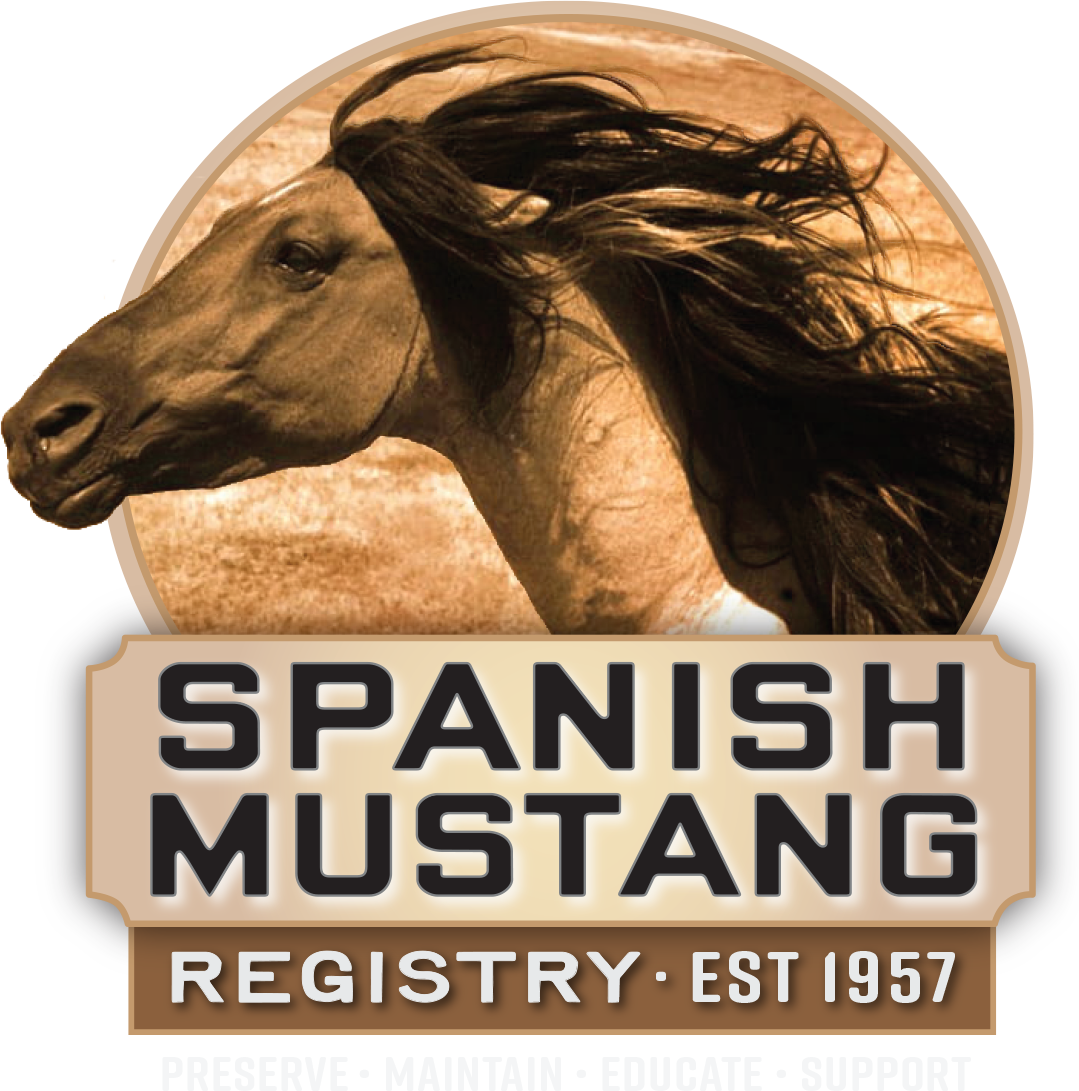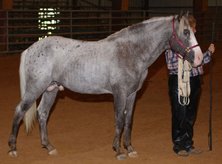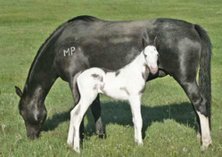Breed Description & Characteristics
The Spanish Mustang is a smooth muscled horse with a short back, rounded rump and low tail set. Coupling is smooth and the overall appearance is of a balanced, well built horse. The girth is deep, with a laid back shoulder and fairly pronounced withers. Consistency in type is important and the Spanish mustang should be immediately discernible upon sight by anyone familiar with the breed. The build of the Spanish Mustang ranges from a heavier type to lighter type without extremes. Heavily defined muscling and height in excess of 15 hands is atypical and should be faulted*. The Spanish Mustang should give the appearance of a natural collection whether in hand or under saddle.
*Characteristic exists that is beyond the parameters of an original SM, this particular characteristic is not typical of an SM. A faulted trait does not indicate that this is not a true SM. Breeding to this faulted trait is not encouraged.
-
Height is approximately 13.2 to 15 hands
Weight 650 to 1100 pounds
Height and weight are in proportion -
The typical head has a flat or convex profile. When viewed from the front, the forehead is broad and will give the impression of an inverted triangle.
The throat latch is well defined and has plenty of room for air passageways. The heavier built horse may have a less defined throat latch than a lighter built horse, but in all the cases the throat latch should be deep with a distinct hollow on the underside of the jaws.
The forehead tapers down into a fairly fine muzzle, muzzles may vary somewhat in size but are never large or coarse.
The mouth is shallow, with no appearance of parrot mouth or under bite. The lips should be fine in appearance with floppy, thick or coarse lips faulted.
The nostrils are set low on the nose. The nostrils are fine, crescent shaped and closed when at rest. When alerted or excited the nostrils are capable of great expansion.
Eyes are fairly wide set and set somewhat higher on the face. Somewhat slanted eyes or almond shaped eyes are normal. Small eyes (pig eyes) or overly large eyes are to be faulted. Eyes may be of any color, these colors may include dark, gray, green, blue, or amber. A white rim (sclera) is acceptable in all colors.
-
The ears are short to medium in length and nicely set upon the head. The ears should not be set too close together or set far apart. The preferred ears are wider at the base than the top and are notched or curved inward at the tips. Ears that are long, narrow, and/or floppy are not typical and should be faulted. The wooly hair, located inside the ears, is often lighter in color than the base coat and is typical for this breed. The ears are often tipped and rimmed with a darker color than the base coat and again is typical for the breed.
-
The neck is well defined in appearance and fits smoothly into the shoulder. Mature stallions should have a well-crested neck that has a smooth arched appearance from the back of the ears to the withers. Mares and gelding will have some crest to the neck, particularly in well-fleshed animals, but the mare should exhibit feminine qualities. The neck length should be approximately the same length as is the distance from the withers to the point of the hip (where the lumbar ends and the sacral starts). Any dip, in the neck, between the poll and the withers (ewe neck) is to be faulted as is any heavy neck crest that falls to one side.
The mane and forelock will be long and full in most animals, although some maybe shorter and thinner. The mane/forelock should be worn at the full, natural length and weight. The mane that falls on both sides of the neck should not be faulted.
-
The shoulder should be well laid back, fitting smoothly into the withers with a 40-45 degree angle preference. The forward point of the shoulder should show prominence. Overly upright shoulders are to be faulted.
-
The chest is moderately narrow with good definition down the center; a well defined “V” should be present between the forelegs. Viewed from the front, the barrel should be plainly visible on both sides of the horse. The points of the shoulder should be defined when viewed from the front and from the side. Viewed from the side, the chest should not appear to be flat nor excessive pigeon chested. The chest may vary with heavier built animals having a wider chest. No Spanish Mustang should have a “bulldog” type chest seen in the Draft or Quarter Horses.
-
Well-defined withers blend smoothly into the back. The back is short, strong and well proportioned. Males can have shorter backs than females. The Spanish Mustang is an “uphill” horse, the Spanish Mustang is square and the feet are positioned under the body. The loin is short, strong and smoothly coupled. The length of the distance from the withers to the point of the hip should be equal to the length of the distance from the poll to the withers. The heart girth is deep with well sprung ribs, thus allowing plenty of heart and lung space. The flank space is short, yet gives balance to the middle of the horse. Long bodied or wasp-waisted horses are to be faulted.
-
Viewed from the side, the hindquarters appear smooth and display strength and roundness, without excessive muscle definition. Level hips are to be faulted. The point of the croup should not protrude upwards in a “hunters bump”. Gaskins are deep with a sloping, rounded croup. The hip joint is well set and low. Viewed from the rear, the Spanish Mustang should appear to be “rafter” hipped.. Hips should not be excessively wide nor narrow or weedy in appearance.
-
The tail is set is a medium low to low set and is well into the rump. The tail is usually carried in a natural relaxed manner, never elevated over the back. Tails will vary in length and thickness, scanty tails, especially in appaloosa patterned horses.
-
The forelegs should be straight with a large broad knee and the middle line of the foreleg going straight down the middle line of the hoof. Both over the knee (buck knee) and back at the knee (calf knee) are to be faulted. The cannon bone is short and round with well-defined tendons. The upper foreleg will be considerably longer than the cannon with adequate muscling. The heavier Spanish Mustang type may have heavier upper arm muscling than the lighter type, but should not be bulgy or bunchy. Horses that are narrow based should be faulted. Paddling or winging out are natural to some Spanish Mustangs and should not be faulted unless, interference is caused in the stride or is caused by a lack of straightness in the leg. The angle of the pastern should be close to or the same as the angle of the shoulder (40-55 degrees).
The rear legs may be set under the body somewhat. An imaginary line projected up from the back of the hind cannon should meet the rear point of the rump. When viewed from the rear the hind legs should be straight and strong in appearance. Narrow based or wide based horses should be faulted. The inner sides of the rear leg should be adequately muscled so as not to appear weak. The gaskin should have adequate muscling and tie smoothly into the rump. The hocks should be clean and lead into medium, short and straight cannons with well defined tendons and suspensory ligaments. Sickle hocks and a horse that camps out should be faulted. Faults in the rear legs that cause interference or undue stress should be faulted.
The pasterns are of moderate length and slope. The angle of the pastern should match that of the shoulder. The rear pasterns may be straighter than the front, but should have length and angle to give maneuverability. Fetlocks should give the appearance of strength and elasticity. Fetlock hair may vary somewhat but should not be “drafty” in appearance. A sparse comb of hair on the back of the legs is typical in some horses and may be evident only in the winter and should not give the appearance of "feather."
Chestnuts, if present, should be small and teardrop shaped, chestnuts should not appear to be ragged or coarse on both the fore and back legs. Chestnuts that protrude are not typical to the Spanish Mustang. Small or non-existent chestnuts are the most desired. Ergots should be small or non-existent on both back and front fetlocks.
-
Hooves should be round and of hard, dense texture with thick walls. Hooves should not have noticeable cracks or blemishes. A “shelly” or excessively flat or flared foot should be faulted. Hoof circumference will be smaller at the coronet band than at the ground surface, thus creating a functional, conical shape with concave sole, prominent frog and full heels. The size of the foot should relate to the size of the horse. Excessively small or large feet are to be faulted. Feet can be black, white, amber, or striped in color.
-
All colors are present in the Spanish Mustang as well as all paint patterns, including appaloosa but excluding tobiano. Many horses exhibit “primitive” markings.
-
The Spanish Mustang is a very “domestic” horse, that is to say they like to be around people. Spanish Mustangs have an affectionate disposition, are curious and alert, observant, quick and eager to learn, and eager to please. Spanish Mustangs are highly intelligent with an innate sense of self-preservation and are intolerant of abuse.
-
Any gait is acceptable, when performed in a smooth, rhythmic manner. However, quality of the individual gait performed by each horse and its overall presentation should be one of pleasing cadence, symmetry, roundness, smoothness and a joy to ride. Every gaited Spanish Mustang is an individual and the gait will be unique to that individual. Some may have a slow gait, others a fast gait and different footfalls can be present.




